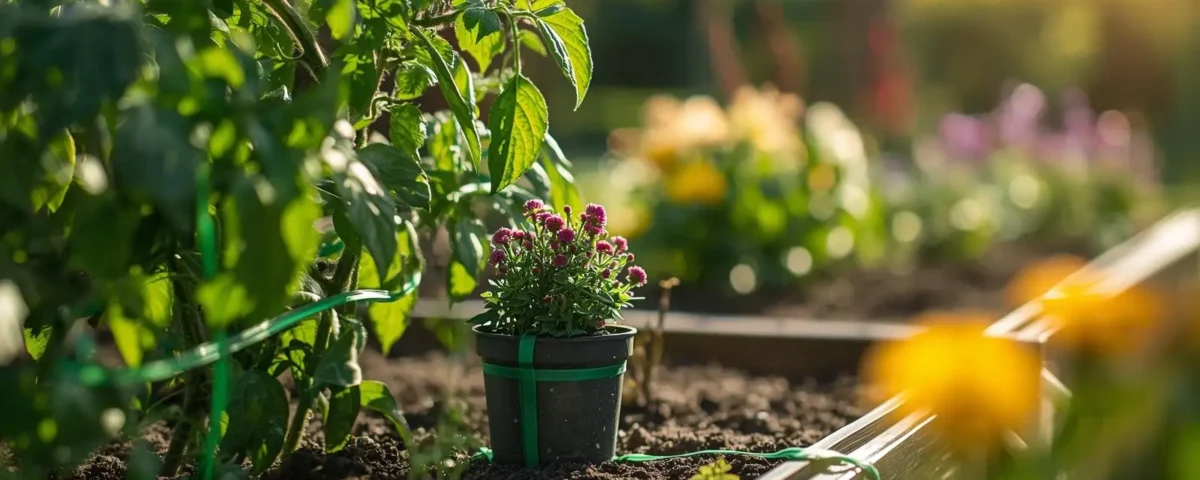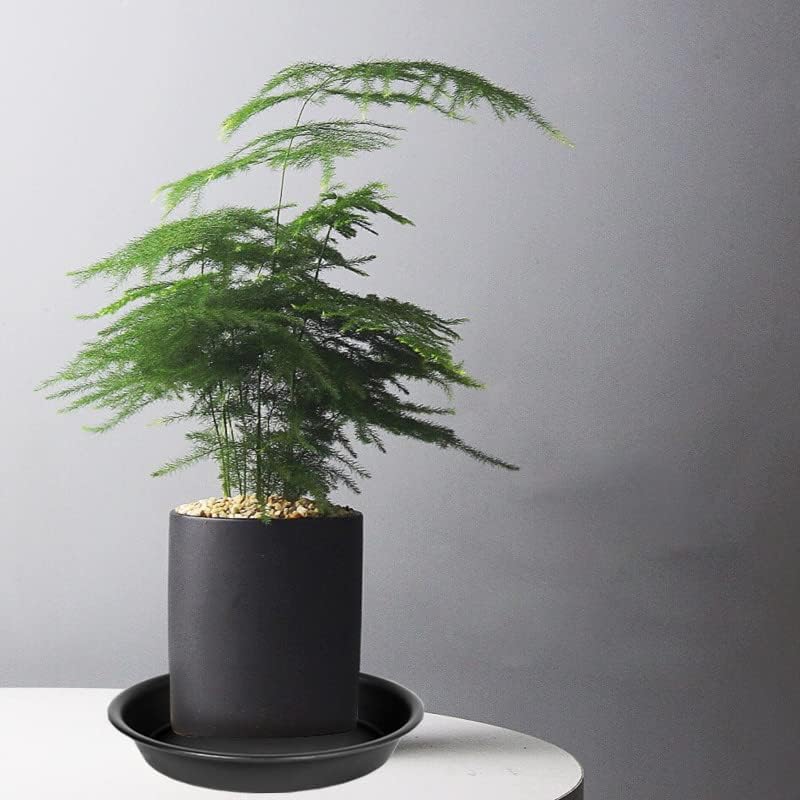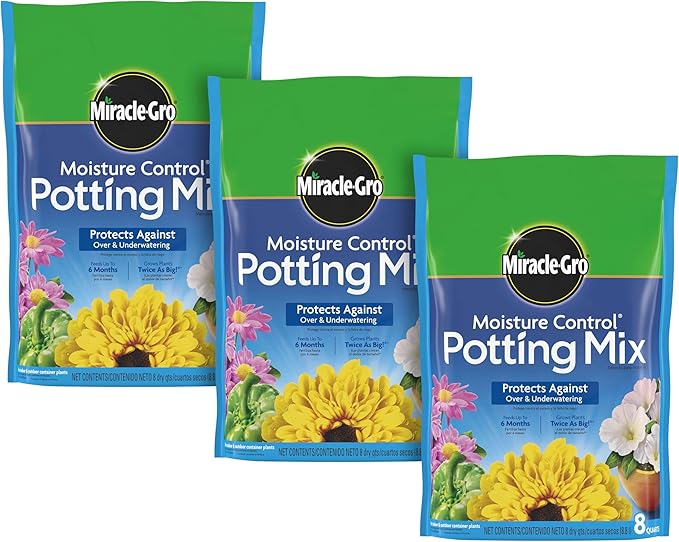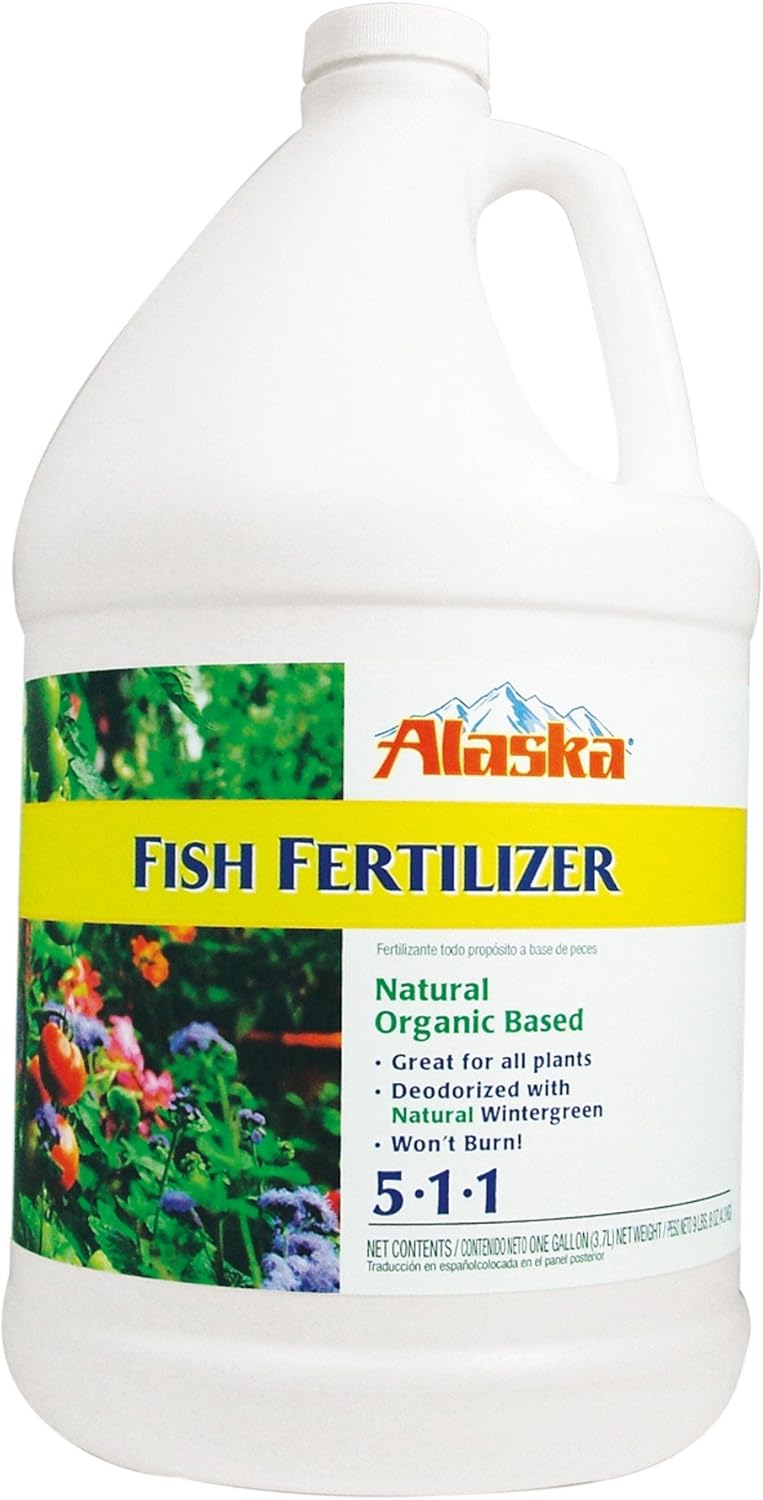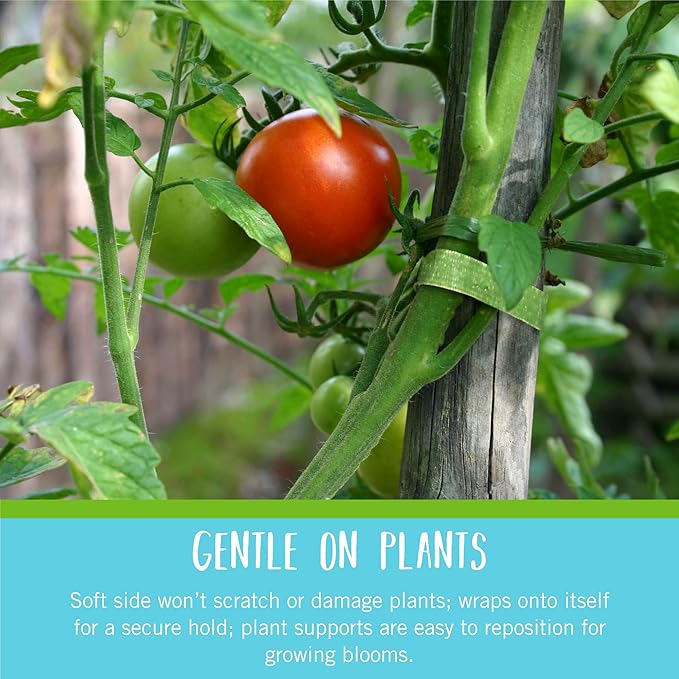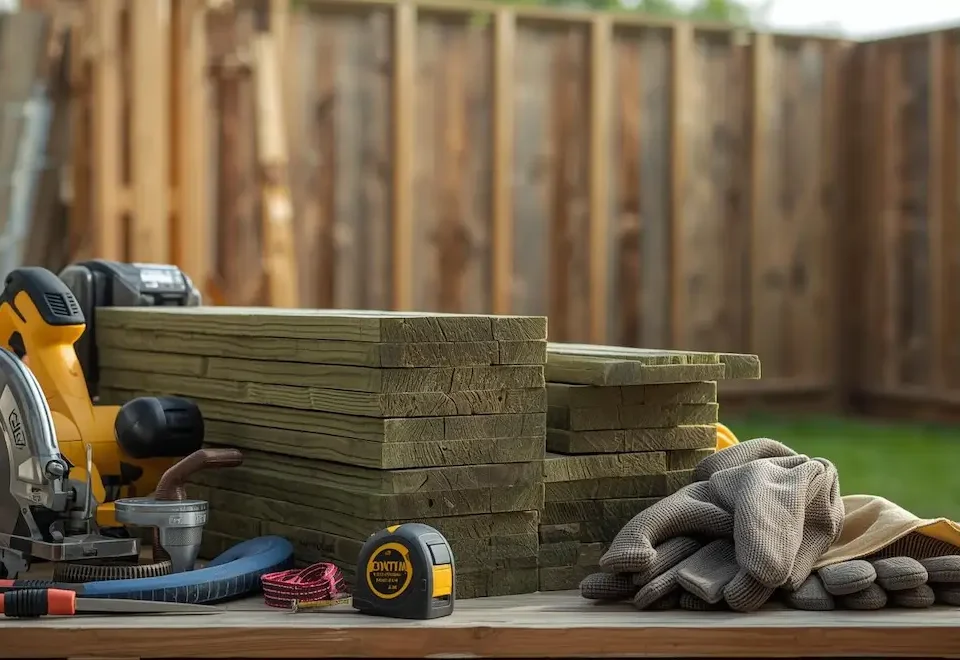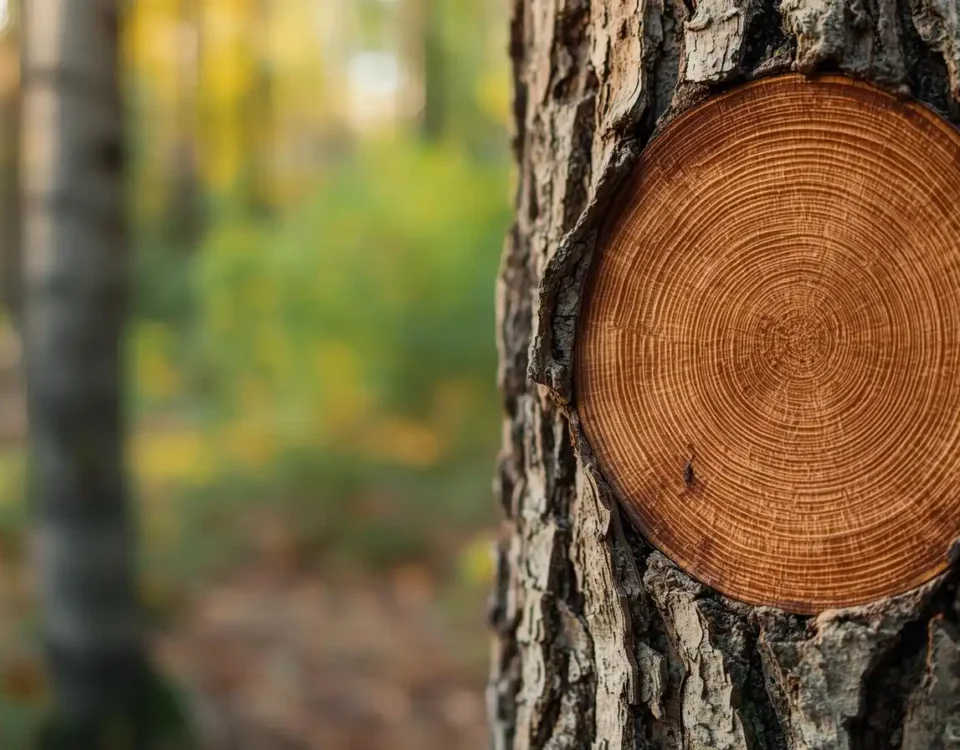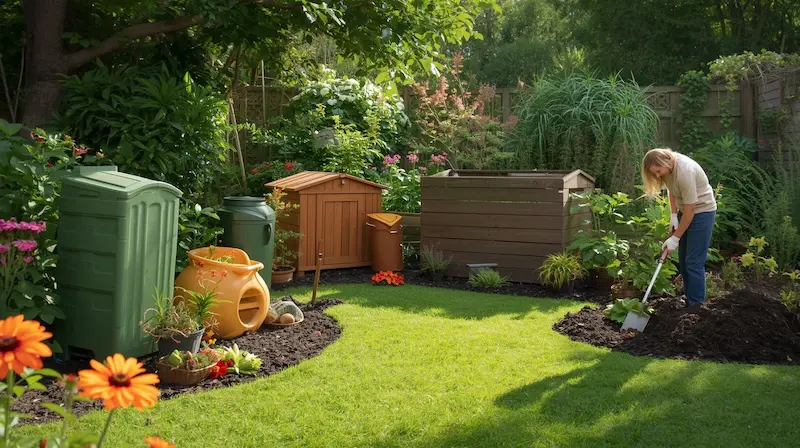
Browning Arborvitae: Expert Guide to Diagnosis & Prevention
October 18, 2025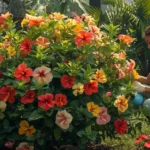
Hibiscus Mastery Top Varieties, Expert Growing Tips & Health Perks
October 22, 2025Introduction
Have you ever admired a beautifully braided money tree, its sturdy, intertwined trunk standing tall as a symbol of prosperity, and wished yours could look the same? Or maybe you’ve just brought home a young Pachira aquatica and feel unsure about how to guide its growth, especially when it comes to braiding or encouraging a thicker, stronger trunk. You’re not alone. Many plant lovers find it challenging to turn a simple money tree into a lush, eye-catching centerpiece that truly thrives, a different challenge than a hugelkultur garden bed.
This guide will take you step by step through the process of cultivating a healthy, visually striking money tree. We’ll go beyond the basics of watering and sunlight to explore how to properly braid stems, thicken the trunk, and overcome common issues like weak growth or unraveling braids. By the end, you’ll understand both the art and science of shaping your money tree with confidence and care.
With a few expert-backed strategies, you’ll learn how to promote steady growth, prevent common mistakes, and maintain the plant’s natural beauty for years to come. Your money tree can be more than just another houseplant; it can become a living piece of art and a source of pride every time you look at it, representing the beauty of homes and looms.
The Foundation: Understanding Your Money Tree
Introduction to Money Tree Care & Aesthetics
The Money Tree (Pachira aquatica) has earned its place as one of the most beloved houseplants, alongside the popular Ficus tree, for both beginners and seasoned gardeners. Recognized for its glossy, palmate leaves and the signature braided trunk that symbolizes prosperity and luck, this tropical beauty adds life and elegance to any indoor space.
What makes the Money Tree truly captivating is the combination of its vibrant foliage and its sculptural trunk. The braided stems, often achieved through gentle training while the plant is young, give it a distinctive, ornamental appearance that many find irresistible. A thick, well-developed trunk not only enhances its visual appeal but also reflects a healthy, mature plant. These aesthetic qualities, braiding and thickening, are what most plant enthusiasts aim to master.
In this section, we’ll establish the foundation for everything that follows. You’ll learn how to provide the right growing conditions to keep your Money Tree thriving and strong, setting the stage for advanced techniques like braiding and trunk development later on.
Basic Money Tree Care Essentials (Foundation for Growth)
Light Requirements
Money Trees grow best in bright, indirect light. Too much direct sunlight can scorch their leaves, while too little light can lead to weak, leggy growth. Place your plant near a window where it receives filtered light throughout the day. Proper lighting gives your Money Tree the energy it needs for new growth, much like the energy required by fast-growing trees for cooling and green living.
Watering Practices
The key to watering a Money Tree is balance. Allow the top inch of soil to dry before watering again, and when you do water, make sure it’s thorough, continuing until water drains out of the pot’s bottom. Good drainage prevents the roots from sitting in water, which can lead to rot.
Expert Tip: Water Consistently, Avoid Waterlogging, and consider plants and mulch for your garden.Maintain steady moisture levels to encourage steady growth, but never let the roots sit in soggy soil. Root rot not only damages the plant but also weakens its stems, making them unsuitable for braiding or training.
Humidity Needs
Money Trees naturally thrive in humid environments, mimicking their tropical origins. To recreate this indoors, mist the leaves regularly, use a humidity tray, or run a room humidifier nearby. This helps prevent leaf dryness and promotes healthy foliage.
Product Recommendation
Consider using a humidity tray or a small room humidifier to maintain optimal moisture levels in the air.
6 Pack 6 inch Plant Saucer Tray, 4 6 8 10 12 15 17 19 inch Plant Saucers, Heavy Duty Plastic Plant Saucers for Indoors, Bird Bath Bowls, Flower Plant Water Trays for pots Planter
-
Perfect Fit for Small Planters: Each Bleuhome plant saucer measures 6.3" at the top, 4.7" at the bottom, and 1.1" deep ideal for pots between 4" and 6" in diameter. This 6-pack provides reliable protection under multiple plants, catching excess water and preventing spills.
-
Thick & Long-Lasting Material: Made from heavy-duty PP plastic, these plant trays are strong, durable, and built to last for years. The matte finish and rounded design give a modern, minimalist look that complements any decor.
-
Protects Furniture & Floors: Designed to catch water overflow and soil drainage, these saucers keep your furniture, floors, and tabletops clean and stain-free. The sleek black color blends seamlessly with any planter style.
-
Versatile Indoor & Outdoor Use: Whether you’re potting plants in your living room, garden, patio, or balcony, these saucers handle all weather conditions. Use them under potted plants, pebble trays, or planters without drainage holes.
-
Practical, Stylish & Reusable: Lightweight yet sturdy, Bleuhome saucers are easy to clean, stack, and store making them a convenient choice for plant lovers and gardeners alike.
LEVOIT Top Fill Humidifiers for Bedroom, 2.5L Tank for Large Room, Easy to Fill & Clean, 28dB Quiet Cool Mist Air Humidifier for Home Baby Nursery & Plants, Auto Shut-off
-
All-Night Humidification: Enjoy up to 25 hours of continuous mist on low mode, thanks to the extra-large 2.5L water tank. Ideal for relieving dry throat, nasal congestion, and skin dryness throughout the night.
-
Convenient Top-Fill Design: LEVOIT’s improved top-fill system eliminates messy refills—simply lift the cover and pour water directly in. No flipping, no spills, no hassle.
-
Effortless Cleaning: Designed with a wide opening and detachable base for quick, thorough cleaning. Say goodbye to mold buildup and hard-to-reach corners.
-
Whisper-Quiet Sleep Mode: Operates at an ultra-low 26dB, making it perfect for bedrooms, nurseries, and home offices. Sleep peacefully with lights off and humidity just right.
-
Adjustable Mist & 360° Nozzle: Control your comfort with a simple knob to fine-tune mist output. The 360° rotating nozzle ensures even humidity distribution in every corner of your room.
Soil & Potting
Your Money Tree will perform best in a well-draining, peat-based potting mix. The goal is to retain enough moisture without becoming compact or soggy. A blend that includes perlite, peat moss, and bark works beautifully to support both aeration and water control.
Product Recommendation: Choose a quality well-draining potting mix with perlite, peat moss, and bark for ideal root health.
Miracle-Gro Moisture Control Potting Mix, For Container Plants, Protects against Over- and Under-Watering, 8 qt., 3-Pack
Give your plants the right foundation with Miracle-Gro® Moisture Control® Potting Mix — specially designed to maintain balanced moisture levels and consistent feeding. Whether you’re growing vibrant flowers or fresh herbs, this potting mix ensures healthy root development and lush growth.
Each bag uses Miracle-Gro’s AquaCoir® blend, a mix of sphagnum peat moss, coir, and a wetting agent that improves water retention and reduces the risk of soil compaction. Use it in containers, window boxes, or hanging planters for reliable performance all season long.
Key Feature
- Feeds Up to 6 Month
- Moisture Control Technology
- Ideal for All Container Plants
Temperature & Fertilization
Money Trees prefer average indoor temperatures, typically between 65°F and 80°F (18°C–27°C). Keep them away from drafts and sudden temperature changes. During the growing season, spring and summer, feed your plant with a balanced liquid fertilizer, such as organic fertilizers for home gardens, once or twice a month to support strong growth and trunk development.
Expert Tip: Fertilize During Growing Season. Supplying nutrients during active growth periods helps fuel the plant’s energy for new shoots and a sturdier, thicker trunk.
Product Recommendation: Use an organic, balanced liquid fertilizer such as a 5-5-5 or 10-10-10 formula for best results.
For general care guidelines, refer to credible sources like university extension services (e.g., University of Florida IFAS Extension, Penn State Extension) and botanical gardens that provide research-based recommendations for Pachira aquatica. Their expertise helps ensure your plant care approach aligns with professional horticultural standards.
Alaska Fish Emulsion Fertilizer 5-1-1 Concentrate 1 Gallon (Packaging may vary)
-
Organic & Gentle Formula: Alaska 5-1-1 Fish Fertilizer is an all-natural, organic nutrient source that won’t burn plants, making it perfect for indoor and outdoor use.
-
Balanced Growth Support: The 5-1-1 NPK ratio provides a rich source of nitrogen for lush, green foliage and steady, healthy growth.
-
Deodorized with Natural Wintergreen: Specially treated to minimize fishy odor leaving a light, refreshing wintergreen scent.
-
Versatile for All Plants: Ideal for lawns, vegetables, flowers, shrubs, trees, and houseplants helps boost vitality and promote strong root systems.
-
Trusted Organic Choice: An excellent eco-friendly fertilizer that improves soil health and provides slow-release nutrients for sustainable growth.
How to Use
-
Dilute the Concentrate: Mix 1 part Alaska Fish Fertilizer with 16 parts water (1:16 ratio).
-
Apply to Soil: Pour the diluted solution directly at the base of plants or across your garden soil.
-
Lawn & Garden Use:
-
For lawns: Apply in early spring and reapply every 4–6 weeks during the growing season.
-
For vegetables: Use when planting and periodically throughout the growth cycle.
-
-
Water Thoroughly: Always water the area after application for best results.
-
Safety Information
-
Keep out of reach of children and pets.
-
Avoid contact with skin and eyes; wear gloves and protective clothing.
-
Do not ingest.
-
Store in a cool, dry place away from sunlight and heat sources.
-
Follow all dilution and application guidelines to prevent overuse and environmental impact.
-
Understanding Money Tree Growth & Physiology
To master the art of shaping your Money Tree, it helps to understand how it actually grows.
Stem Development
Like many woody plants, the Money Tree experiences two types of growth. Primary growth involves the elongation of stems; this is how the plant gains height. Secondary growth, on the other hand, occurs within the cambium layer, a thin ring of living tissue that adds new layers of cells beneath the bark. This process thickens the trunk and gives the plant its strong, mature structure.
Plant Response to Pruning & Training
Money Trees naturally follow a process called apical dominance, meaning the main top stem tends to grow faster than side branches. When you prune or pinch off the top growth tip, the plant redirects its energy into lateral stems, encouraging a fuller canopy and thicker trunk.
This redirection of energy also influences hormonal balance within the plant. Hormones like auxins (which promote upward growth) and cytokinins (which stimulate branching) work together to determine how the plant responds to pruning or braiding. Understanding this relationship helps you shape your Money Tree more effectively.
The Art of Braiding Money Tree Stems
Preparing Your Money Tree for Braiding
Braiding is one of the most distinctive and rewarding techniques in Money Tree care. It combines aesthetic creativity with gentle horticultural skill, transforming simple stems into an elegant, intertwined trunk that symbolizes growth and harmony. Before you begin, it’s important to set the stage properly so your plant adapts comfortably to its new shape.
Selecting Suitable Stems
The best results come from young, flexible stems. Mature trunks become woody and rigid, making them difficult to braid without risk of snapping or scarring. Ideally, choose a Money Tree that is 6 to 12 inches tall and still developing soft green stems that can be gently manipulated.
Most braids are created using three or five stems, depending on the look you want. A three-stem braid is the most common and easiest to maintain, while a five-stem braid creates a fuller, more intricate appearance. The stems should be relatively equal in length and thickness for a balanced braid that grows uniformly over time.
Initial Pruning for Shape
Before braiding, take a few minutes to prune and prepare your plant. Remove a few of the lower leaves on each stem to make space for your hands and reduce crowding around the base. If you notice any stems that are weak, damaged, or growing unevenly, trim them back. This not only improves symmetry but also ensures that the plant channels its energy into the strongest stems, those most likely to develop into a healthy, cohesive braid.
Expert Tip: Start Braiding Early. The best time to braid a Money Tree is when its stems are still young and flexible. Early braiding allows the stems to naturally grow together over time, strengthening the structure as they mature. Attempting to braid older, hardened trunks can cause stress or breakage, leading to uneven growth and potential scarring.
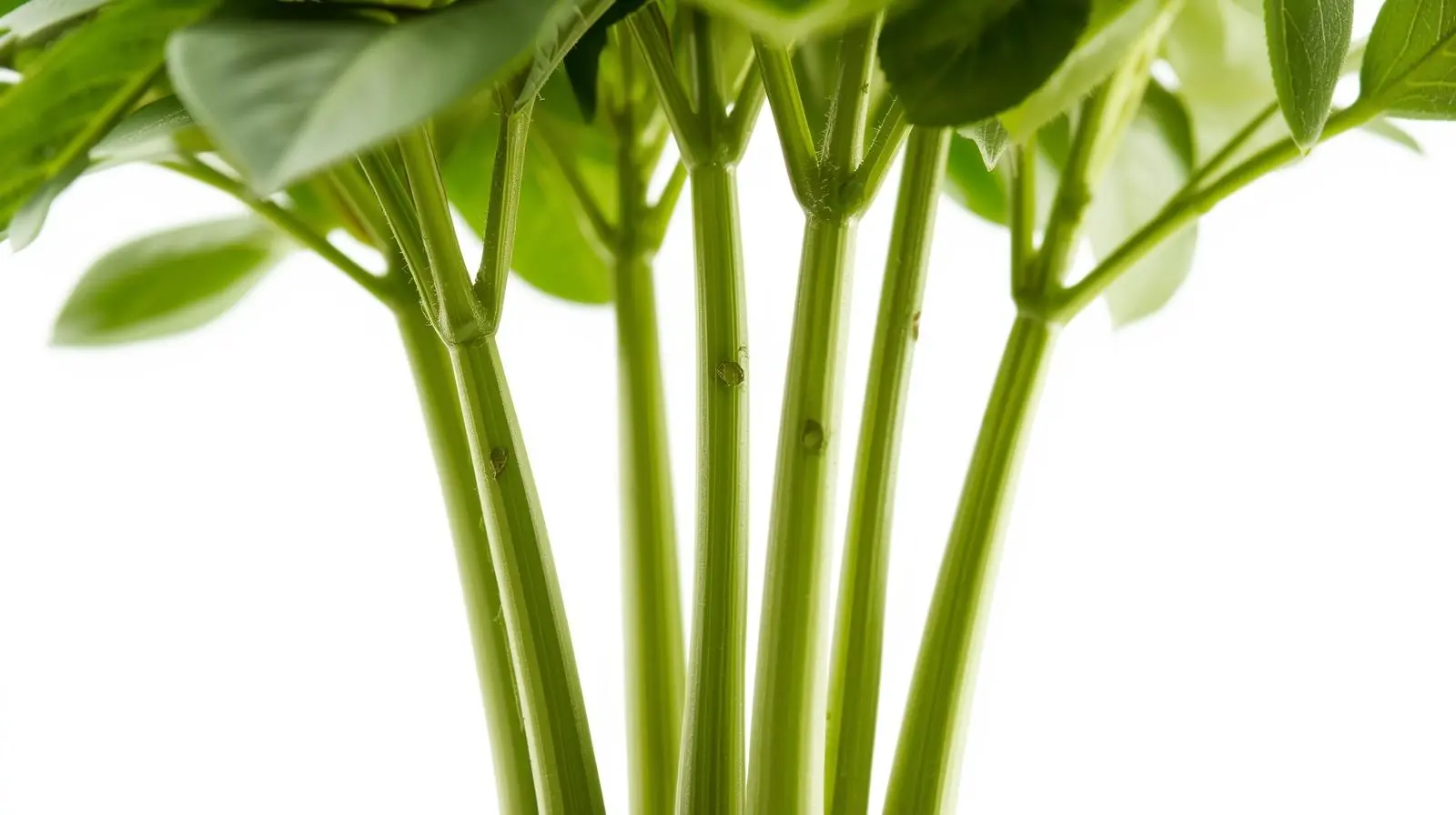
Step-by-Step Guide to Braiding
Braiding your Money Tree is a hands-on process that requires patience, gentleness, and a clear understanding of how the plant grows. Each step builds on the last to help you create a secure, even braid that enhances both the strength and appearance of your plant. Whether you’re working with three or five stems, the key is to move slowly and allow the plant to adjust as it grows.
Handling Different Numbers of Stems
- Three-Stem Braid: This is the traditional and simplest style. It creates a neat, symmetrical trunk that’s easy to maintain and ideal for beginners.
- Five-Stem Braid: This variation offers a fuller, more intricate look but requires extra attention. The process is the same: cross each outer stem toward the center, but you’ll need to braid more carefully to maintain symmetry and even tension.
Expert Advice:
- Never force a stem that resists bending; slightly reposition it instead.
- If the stems are slightly stiff, mist them with water before braiding to increase flexibility.
- Braiding is best done during spring or early summer, when growth is active, and the plant recovers quickly from handling.
Securing and Maintaining Your Braid
Once your Money Tree is neatly braided, the next step is keeping it secure and healthy as it continues to grow. The key here is balance; you want the braid to hold its shape without restricting the plant’s natural development.
Gentle Tying
Use soft ties or twine to secure the braid at intervals, particularly at the base and near the top. Materials like Velcro plant ties, jute twine, or fabric strips are ideal because they’re flexible and gentle on the stems. Avoid metal wires or anything that could cut into the bark. Wrap the tie loosely, just tight enough to hold the braid in place while still allowing space for the stems to expand.
Regular Adjustments
As your Money Tree grows, the stems will thicken and expand naturally. It’s important to check your ties every few weeks to make sure they aren’t becoming too tight. If you notice the ties digging into the bark, loosen or replace them right away. This small habit prevents girdling, a condition where constriction interrupts the plant’s sap flow and can permanently damage or deform the trunk.
Expert Tip: Don’t Over-Tighten Braids. Always leave a little room for the stems to grow and swell over time. Tight braids or ties can cut into the bark, restricting nutrient flow and slowing down trunk development. A gentle touch ensures the braid stays healthy and natural-looking.
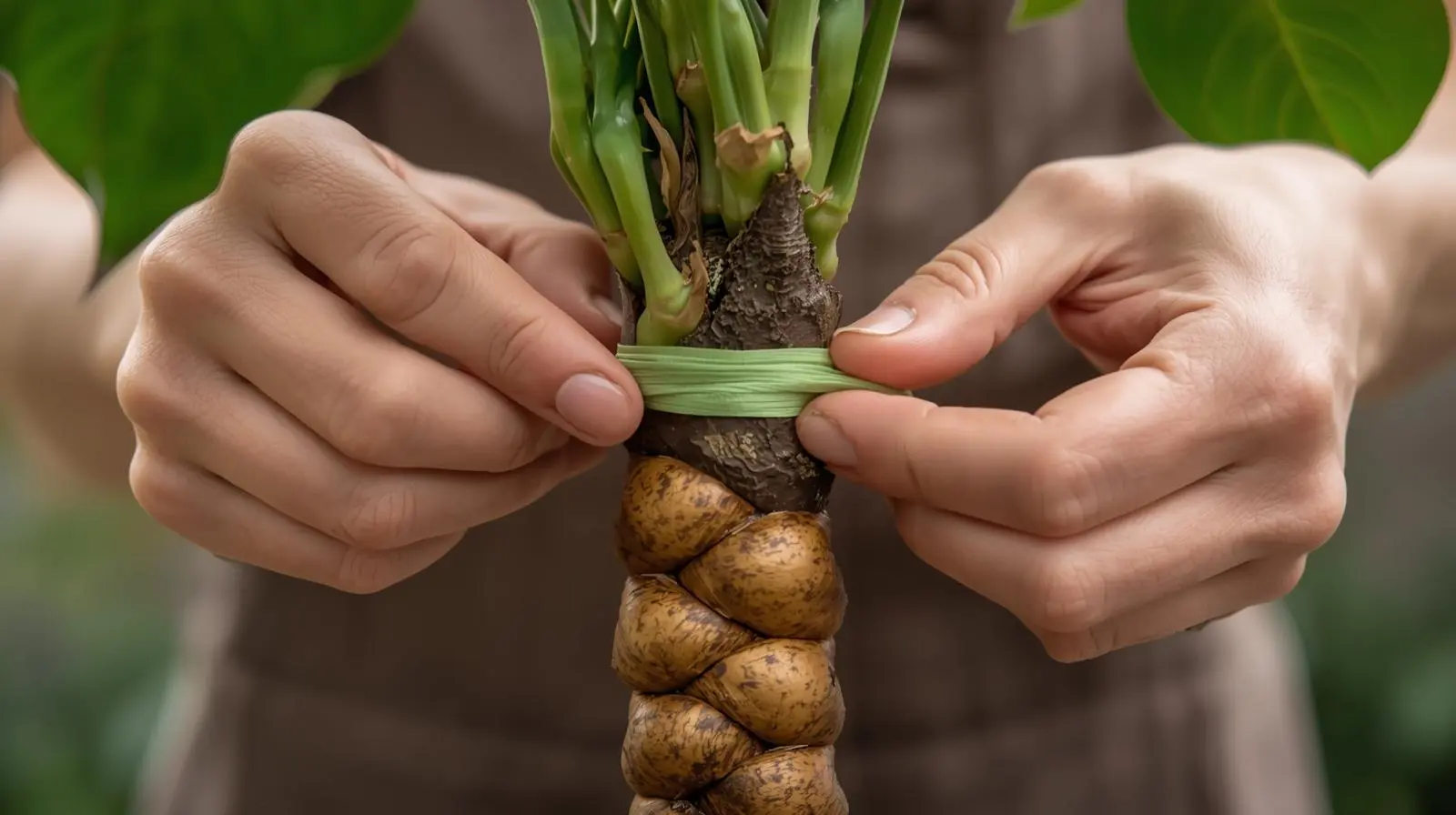
Advanced Braiding Patterns & Creative Styling
Once you’re comfortable with the classic three-stem braid, you can explore more creative and intricate braiding styles. These advanced patterns allow you to express artistry while giving your Money Tree a one-of-a-kind structure.
Double Braids
This technique involves creating two separate braids side by side within the same pot. Over time, these braids can be gently twisted together to form a visually striking, interwoven design. It gives a fuller look and adds depth to the trunk’s appearance.
Basket Weave Pattern
For experienced growers, a basket weave design offers an artistic, geometric finish. It requires several young stems (usually 6–8) arranged in a square pattern and woven horizontally and vertically as they grow. While this method takes time and precision, the result is a truly standout specimen that looks like a natural sculpture.
Incorporating Support Structures
For more complex designs, consider using a support stake or frame to guide the stems as they grow. Soft ties can be attached to these supports to keep the pattern neat and even. Just remember to remove or adjust them regularly as the plant matures to prevent damage.
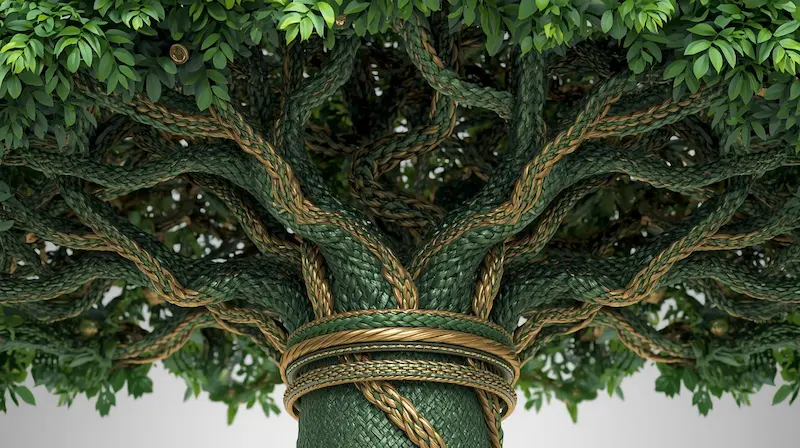
Cultivating a Robust Trunk: Thickening Techniques
A thick, well-developed trunk gives a Money Tree both strength and beauty. Beyond aesthetics, a sturdy trunk helps the plant support its lush canopy and braided form over time. Achieving that structure requires patience, consistent care, and a good understanding of how the plant naturally grows.
Pruning Strategies for Thicker Stems
Strategic Pruning
Pruning plays a central role in encouraging trunk thickening, but proper techniques are crucial to avoid issues like lion's tailing. When you remove the growth tips (the apical buds) from the top of the plant, it disrupts the natural dominance of that top shoot. This redirection of energy encourages the Money Tree to push out lateral branches, spreading growth energy more evenly throughout the plant. The result is a bushier canopy and thicker, stronger stems.
Encouraging Bushiness
To achieve a fuller shape, use selective pruning, cutting just above a leaf node (the point where a leaf meets the stem). This signals the plant to produce two or more new branches at that point. Over time, the increased branching stimulates secondary growth, which strengthens the trunk and creates a more compact, robust form.
Expert Tip: Prune for Bushiness, Not Just Height. Avoid letting your Money Tree grow tall and leggy. Instead, trim back the top growth to encourage side shoots. This approach helps develop thicker stems and a balanced, symmetrical structure that supports the plant’s overall health and stability.
Product Recommendation: Use sharp, sterilized pruning shears (bypass pruners are ideal) to make clean, precise cuts. Sterilizing your tools before each use prevents bacterial or fungal infections that can weaken the plant.
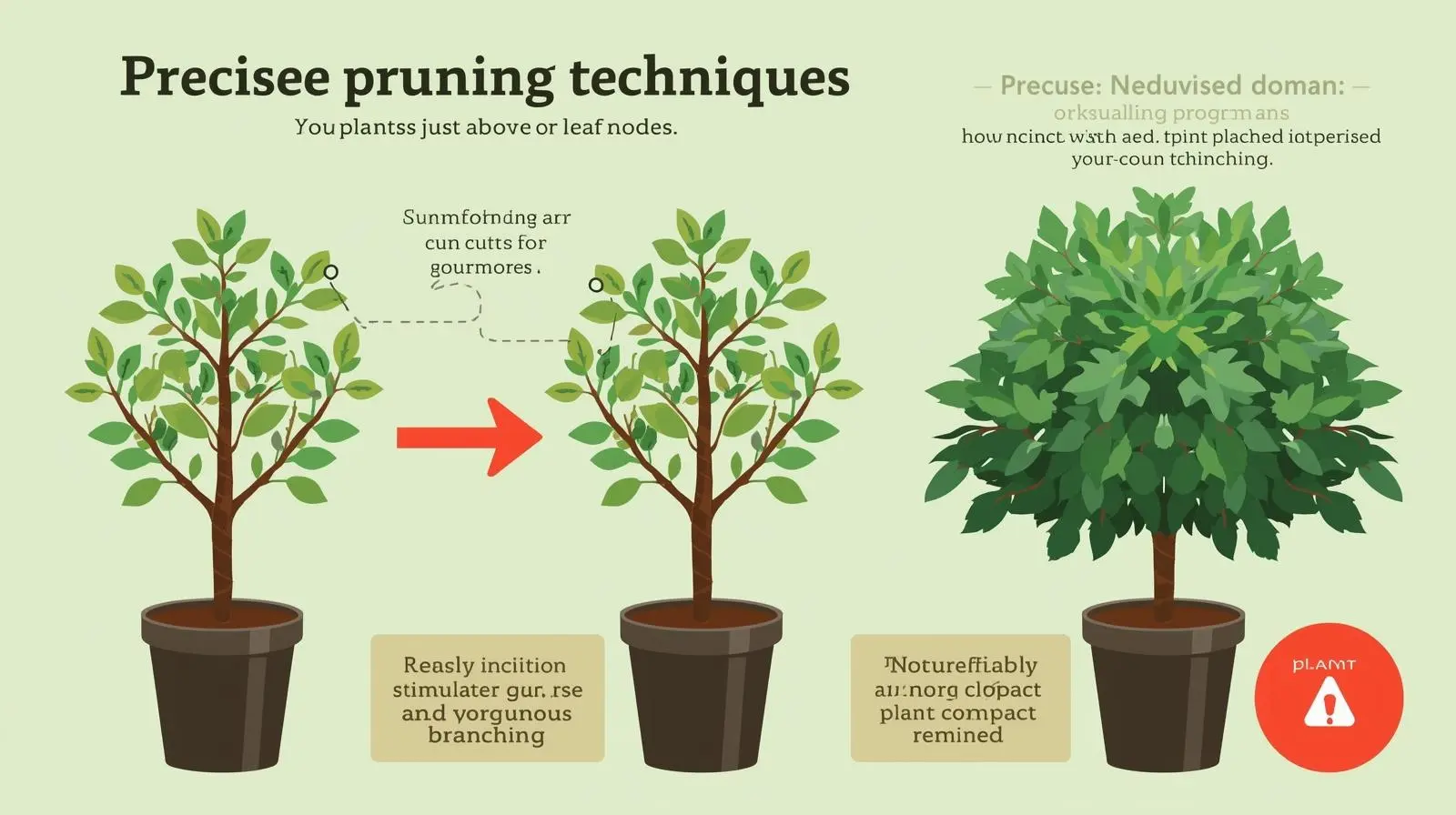
Environmental Optimization for Growth
While pruning shapes the structure, environmental factors determine how strong and healthy your Money Tree becomes.
Light
Money Trees need bright, indirect light to produce enough energy for thickening and sustained growth. Rotate your plant regularly so that all sides receive equal exposure.
Expert Tip: Rotate Your Plant Regularly. Turning your Money Tree every week or two helps ensure even growth, preventing one side from leaning toward the light and encouraging symmetrical trunk development.
Watering
Keep the soil consistently moist but not soggy. Underwatering leads to weak, thin stems, while overwatering can cause root rot. Striking the right balance supports steady, healthy growth from the roots upward.
Humidity
Maintain moderate to high humidity around the plant to promote robust foliage and stem health. Regular misting or using a humidifier helps create the right microclimate.
Fertilization
Feed your Money Tree during the growing season (spring and summer) with a balanced liquid fertilizer (such as 10-10-10). Adequate nutrition provides the energy and building blocks needed for thicker stems and stronger cell walls.
Comparative Overview of Trunk Thickening Methods
Each thickening method offers unique benefits and challenges. Combining techniques, such as pruning with environmental optimization, usually produces the best results.
|
Method |
Description |
Pros |
Cons |
Ideal Application |
|
Pruning |
Strategically removing top growth to redirect energy into existing stems and promote lateral branching. |
Simple, effective, encourages bushiness and secondary growth. |
Slower results require consistent upkeep. |
Best for beginners and regular maintenance. |
|
Environmental Optimization |
Providing ideal conditions, light, water, humidity, nutrients, for vigorous, healthy growth. |
Supports natural thickening, improves overall vitality. |
Indirect; results depend on existing plant health. |
Essential baseline for all thickening techniques. |
|
Air Layering |
Encouraging roots to form on a section of the stem while it remains attached to the parent plant, then separating it once established. |
Produces noticeable thickening in the targeted area. |
Advanced, time-intensive, risk of failure. |
For experienced growers aiming to thicken specific trunk sections. |
|
Grafting |
Joining two plant parts (scion and rootstock) so they grow as one. |
Can introduce desirable traits and accelerate thickening. |
Technical, uncommon for Money Trees, high risk. |
Rarely used by hobbyists; best left to experts. |
Optimizing Growth for Aesthetics and Health
A beautifully trained Money Tree isn’t just pleasing to the eye; it’s also stronger, healthier, and more resilient. When done correctly, braiding and trunk-thickening techniques not only enhance the plant’s visual symmetry; they also support its long-term structural integrity and overall well-being.
The Connection Between Form and Function
Every twist, prune, and adjustment you make shapes how your Money Tree grows, not just outwardly but internally. Proper braiding aligns multiple stems so they grow in unison, creating a stable base that supports lush foliage. As the stems mature and fuse, they share nutrients and water more efficiently, building a sturdy foundation that resists bending or breaking.
Similarly, consistent pruning and controlled thickening improve air circulation within the canopy. This reduces the risk of fungal problems and allows light to penetrate evenly through the leaves. The result is not only a balanced, sculpted appearance but also a plant that can photosynthesize more effectively and grow more vigorously, contributing to the global forest count.
Strength from the Inside Out
When trained properly, a Money Tree develops a more robust root system that mirrors its structure above the soil. Healthy roots anchor the plant firmly and absorb nutrients more efficiently, which in turn fuels thicker stems and denser foliage. Over time, the combination of braiding, pruning, and environmental care produces a plant that’s visually impressive and structurally sound, a living example of harmony between art and science.
Unique Angle:
The artistry of braiding and the science of plant physiology work together. A well-braided, properly thickened Money Tree doesn’t just look elegant; it functions better. It stands upright without support, circulates air freely through its canopy, and resists stress from environmental changes. In short, mastering these techniques isn’t just about creating beauty; it’s about building resilience.
Benefits at a Glance:
- Improved Structural Integrity: Braided stems fuse into a single, sturdy trunk that supports growth naturally.
- Better Air Circulation: Pruning and shaping open up the canopy, reducing disease risk and promoting even growth.
- Enhanced Root Development: Healthy, balanced top growth encourages strong root expansion and nutrient absorption.
- Long-Term Health: A well-trained Money Tree lives longer, maintains its shape, and continues to thrive with minimal correction.
When approached with care and patience, aesthetic training becomes a form of plant wellness. The same techniques that make your Money Tree beautiful also make it resilient, proving that in nature, true beauty and health always go hand in hand.
Troubleshooting & Advanced Care for Your Money Tree
Even with the best care, your Money Tree can run into issues during the braiding or thickening process. Recognizing early signs of stress and knowing how to respond keeps your plant healthy and looking its best, much like diagnosing browning arborvitae. This section acts as your quick reference for diagnosing and fixing common problems. Think of it as your personal “Money Tree Doctor.”
Common Braiding & Thickening Problems: Troubleshooting & Solutions
Unraveling Braids
- Cause: The stems weren’t secured properly, or they’ve become too rigid to hold the braid.
Solution: Use soft plant ties or twine to gently re-secure the braid. If stems have hardened, wait for new, flexible growth and re-braid those sections. Always ensure young stems are pliable before starting.
Slow or Uneven Trunk Thickening
- Cause: Inconsistent watering or light exposure, nutrient deficiencies, or over-tight ties restricting sap flow.
Solution: Ensure your plant receives bright, indirect light, maintain a regular watering schedule, and feed with a balanced fertilizer every few weeks during the growing season. Loosen ties slightly to allow for natural stem expansion.
Stem Damage (Breaking or Scarring) During Braiding
- Cause: Braiding stiff stems or twisting too forcefully.
Solution: Only braid while stems are young and flexible. If damage occurs, prune the affected area cleanly with sterilized shears to prevent infection and promote regrowth, preventing sudden branch drop syndrome. Patience is key; forcing stiff stems will cause more harm than good.
Yellowing Leaves After Pruning
- Cause: Temporary plant stress, shock from over-pruning, or watering imbalance.
Solution: Limit pruning to 20–25% of total foliage at once. Maintain steady watering (allowing the top inch of soil to dry between sessions), and avoid direct sunlight for a few days post-pruning. If yellowing persists, consider mild nutrient supplementation.
Pest or Disease Infestation
- Cause: Stressed plants are more prone to pests such as spider mites or mealybugs, often due to dry air or overwatering.
- Solution: Inspect leaves and stems regularly. If pests are found, wipe the leaves with a mild soap-and-water solution or neem oil spray. Increase humidity and airflow to deter recurrence.
Expert Tip: Inspect Regularly for Pests: A healthy, pest-free Money Tree responds better to all forms of training and thickening. Prevention is far easier than treatment.
Assessing the Health of a Struggling Money Tree
Start by examining your plant from the soil up.
- Roots: Gently loosen the plant from its pot. If roots are brown, mushy, or circling tightly, it’s time for repotting. Healthy roots should be firm and white.
- Stems: Look for signs of rot, scarring, or brittleness. Any blackened or hollow sections should be pruned away.
- Leaves: Yellowing, drooping, or sparse leaves usually point to overwatering, poor light, or nutrient deficiencies.
Quick Fix: Relocate the plant to bright, indirect light and check watering habits. Most stressed Money Trees recover best when the top inch of soil dries before watering again.
Corrective Pruning for Recovery
Pruning helps redirect a plant’s energy to healthier parts.
- Remove Dead or Damaged Sections: Use sterilized pruning shears to make clean cuts above a node or healthy stem joint.
- Encourage Regrowth: Trim back spindly or overly tall stems to stimulate new side shoots. This encourages bushiness and strengthens the trunk over time.
- Expert Tip: Prune for Structure, Not Just Cleanliness. When recovering a plant, every cut should serve a purpose, either to restore shape or improve airflow.
-
Gentle Re-braiding Techniques
Older stems are stiffer and less flexible, so re-braiding requires care.
- Soften the Stems: Mist them lightly or wrap them with a damp cloth for an hour before handling.
- Work Slowly: Move the stems gently into position, securing each crossover point loosely with soft ties.
- Partial Braids: If full re-braiding isn’t possible, braid only the newer, flexible sections and leave older trunks as a natural anchor.
- Soften the Stems: Mist them lightly or wrap them with a damp cloth for an hour before handling.
Encouraging New Growth
Once pruning and re-braiding are complete, help your Money Tree recover its vigor:
- Light: Place it in bright, indirect sunlight for 6–8 hours daily.
- Water: Keep soil evenly moist but never soggy.
- Feeding: Apply a balanced liquid fertilizer every 4–6 weeks during the growing season.
- Humidity: Mist leaves occasionally or use a pebble tray to prevent drying.
Healthy new shoots will eventually become the foundation for future braids or thicker trunks.
Horticulturalist’s Corner: Expert Insights
“The Money Tree responds beautifully to patient, consistent care. Structural integrity comes from small, regular adjustments, never quick fixes.”
, Elena Kwan, Certified Horticulturalist & Indoor Plant Specialist
Elena emphasizes that trunk thickening and aesthetic shaping go hand in hand. The key is not to rush the process. “Plants, like people,” she adds, “respond best to gentle guidance rather than force.”
Additional Expert Takeaways:
- Long-Term Structure: Maintain a balance between height and width to prevent top-heavy leaning.
- Psychology of Plant Care: Regular observation helps you understand your plant’s rhythm, spotting subtle signs of stress before they escalate.
- Common Misconception: Many assume more water or fertilizer means faster growth. In reality, restraint and rhythm create stronger, healthier stems.
When & How to Repot (and Its Impact on Trunk Growth)
Repotting Schedule
Repot your Money Tree every 1–2 years or whenever it becomes root-bound.
Signs it’s time:
- Roots circling the bottom of the pot.
- Water is draining too quickly or pooling at the surface.
- Slowed growth despite proper light and feeding.
Repotting Technique
- Gently remove the plant and shake off excess old soil.
- Inspect the roots, trim any dead or mushy ones with sterilized shears.
- Place in a pot 1–2 inches larger in diameter than the old one.
- Refill with well-draining potting mix, pressing gently around the roots.
Product Recommendation: Use a light, well-draining mix such as peat, perlite, and coarse sand for optimal aeration.
Expert Tip: Use the Right Pot Size: A pot that’s too large can cause waterlogging, while a pot that’s too small can restrict root growth, both of which limit trunk thickening.
Long-Term Maintenance & Care for Braided or Thickened Trunks
Ongoing Pruning
Continue pruning lightly every few months to maintain shape and remove any dead or diseased foliage. This keeps the plant open for airflow and light penetration.
Re-braiding & Tie Adjustments
As new growth appears, continue the braid pattern upward. Check all ties monthly and loosen them to accommodate expanding stems.
Continued Vigor
Consistent basic care, light watering, and feeding are what sustain a healthy trunk. Avoid overhandling or frequent repositioning; stability encourages stronger root anchoring.
Expert Tip: Patience is Key: Braiding and thickening are gradual processes. The most striking, resilient Money Trees are those given years of steady care rather than quick, forced shaping.
Essential Tools & Resources for Money Tree Mastery
Achieving a beautifully braided and thickened Money Tree is easier when you have the right tools at hand. While basic care items are important, certain specialized tools make braiding, pruning, and promoting trunk growth far more effective and precise.
Recommended Tools for Braiding & Thickening
- Soft Plant Ties / Twine
- Gentle and adjustable, these are essential for securing braids without constricting the stems.
- Examples: Velcro plant ties, jute twine, or soft fabric strips.
- Gentle and adjustable, these are essential for securing braids without constricting the stems.
- Sharp, Sterilized Pruning Shears
- Clean cuts reduce stress and prevent infection, supporting healthy lateral growth.
- Bypass pruners are ideal for precision trimming of stems and roots.
- Clean cuts reduce stress and prevent infection, supporting healthy lateral growth.
- Organic, Balanced Liquid Fertilizer
- Provides essential nutrients to fuel vigorous growth, aiding both foliage development and trunk thickening.
- Recommended formulations: 5-5-5 or 10-10-10 during the active growing season.
- Provides essential nutrients to fuel vigorous growth, aiding both foliage development and trunk thickening.
- Well-Draining Potting Mix
- Promotes root health, prevents waterlogging, and allows steady trunk growth.
- Mixes containing peat moss, perlite, and bark offer excellent aeration and drainage.
- Promotes root health, prevents waterlogging, and allows steady trunk growth.
- Humidity Tray or Room Humidifier
- Maintains ideal humidity levels, reducing stress and promoting lush, healthy growth.
- Maintains ideal humidity levels, reducing stress and promoting lush, healthy growth.
- Grow Lights (Full-Spectrum LED)
- Supplemental light is useful when natural sunlight is insufficient.
- Supports consistent growth for both young stems and mature trunks.
- Supplemental light is useful when natural sunlight is insufficient.
- Soft-Coated Plant Training Wire (Optional for Advanced Users)
- Guides specific stem directions gently, useful for more intricate braiding or creative shaping.
- Guides specific stem directions gently, useful for more intricate braiding or creative shaping.
Conclusion Mastering the Art of the Money Tree
Cultivating a beautifully braided and thickened Money Tree is both an art and a science. From selecting young, pliable stems to encouraging trunk thickening through pruning and environmental optimization, the process requires patience, consistency, and attentive care. Understanding the plant’s physiology, how it responds to light, water, pruning, and hormonal signals, empowers you to guide its growth effectively, resulting in a strong, healthy, and visually stunning specimen.


